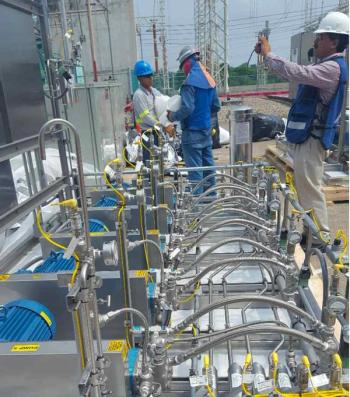
Active Magnetic Bearings: An Alternative to Fluid Film Technology
ONCE LIMITED TO NICHE APPLICATIONS, AMBS ARE NOW A COST-EFFECTIVE REPLACEMENT FOR TRADITIONAL BEARINGS
Fluid film bearings are widely used in rotating equipment applications. However, they have a footprint and maintenance-intensive nature that put them out of alignment with the desire of owners and operators to cut costs and reduce environmental impact.
Fluid film bearings rely on petroleum-based oils to support rotating shafts and, therefore, need regular lubrication. Typically, this is done with a dedicated lube oil system, which consists of oil reservoirs, pumps, filters, heat exchangers, and auxiliary piping. This can be problematic, particularly in the oil and gas industry where space is limited, cleanliness is critical, and there is little tolerance for expensive downtime.
More stringent environmental regulations, too, coupled with the rising cost of storing and disposing of flammable waste oil have further complicated material-handling operations. In addition, friction and fluid drag on fluid film bearings contribute to lower operating efficiencies. On high-speed rotating applications this can represent a significant chunk of total energy consumption. Active magnetic bearings, however, are now a viable alternative to fluid film bearings.
Figure 1: Dresser-Rand DATUM compressor bundle
Figure 2: Cutaway of a shaft under 5-axis support showing Synchrony AMB components
Figure 3: Final wiring of multi-sector, radial Synchrony AMB stator[/caption]
Overcoming limitations
In the early stages of their development, AMBs had to be much larger than conventional bearings due to limitations in available bearing pressure and sensor technology. Recent advances in miniaturization and standardization have shifted the equation in favor of AMBs. The design of magnetic bearing actuators has improved. Increasing the amount of electrical steel at the bore of the stator has boosted bearing pressure, closing the gap. And the use of eddy current sensors has allowed the axial length of AMBs to be decreased (Figure 1).
Advances in frequency-modulated sensing techniques and digital electronics have also reduced the size of the associated control systems. Though at one time as big as a refrigerator, AMB controllers are now similar in size to a household DVD player. Wiring between electromagnets, coils and sensors has also been lessened (Figure 2).
AMBs operate on the principal of magnetic levitation. Two radial magnetic bearings are used to support and position a shaft in the lateral (radial) directions and one thrust bearing is used to support and position the shaft along the longitudinal (axial) direction. A shaft that is completely supported by magnetic bearings provides support along five axes: two axes for each radial bearing (x-y) and one translational axis (z) for the thrust bearing.
Stationary electromagnets around the rotating assembly suspend the rotor in the stator. With no contact between surfaces, drag and friction are virtually eliminated which leads to higher efficiency and lower power consumption. Without surface contact, a lubrication system becomes unnecessary, thereby reducing maintenance requirements and lowering the overall footprint.
Complexity is lowered in other ways by the presence of AMBs. Consider health monitoring. Many rotating applications with conventional bearings require a dedicated vibration monitoring system consisting of relatively expensive proximity probes, data acquisition systems, conditioning electronics and digital processors.
With active magnetic bearings, this capability is inherent. Sensors on each bearing measure parameters such as temperature, shaft position, voltage, flux, force and current. All of this data is recorded and analyzed over time so that trends can be identified, and system abnormalities flagged and examined.
The reliability of active magnetic bearings makes them a candidate for operation in extreme environmental conditions. For example, as lubricant viscosity increases as temperature drops, fluid film applications are not well suited for extremely cold conditions. AMBs perform well in cold or subsea settings.
Similarly, AMBs perform well in hightemperature environments which can produce mechanical issues in conventional bearing systems due to thermal expansion of metal surfaces. As AMBs do not require lubricants or contact between metal surfaces, they are less susceptible to temperature variations, making them capable of performing in harsh environments.
Making the switch
For those looking to further improve the environmental friendliness of their operation by reducing the turbomachinery footprint, active magnetic bearings should be considered. With no energy losses due to friction and nominal maintenance requirements, they can serve as a cost-effective alternative to fluid film bearings.
Written by: Ralph Kopera, Manager for Client Services at the Dresser-Rand Synchrony Business Unit.
Newsletter
Power your knowledge with the latest in turbine technology, engineering advances, and energy solutions—subscribe to Turbomachinery International today.





